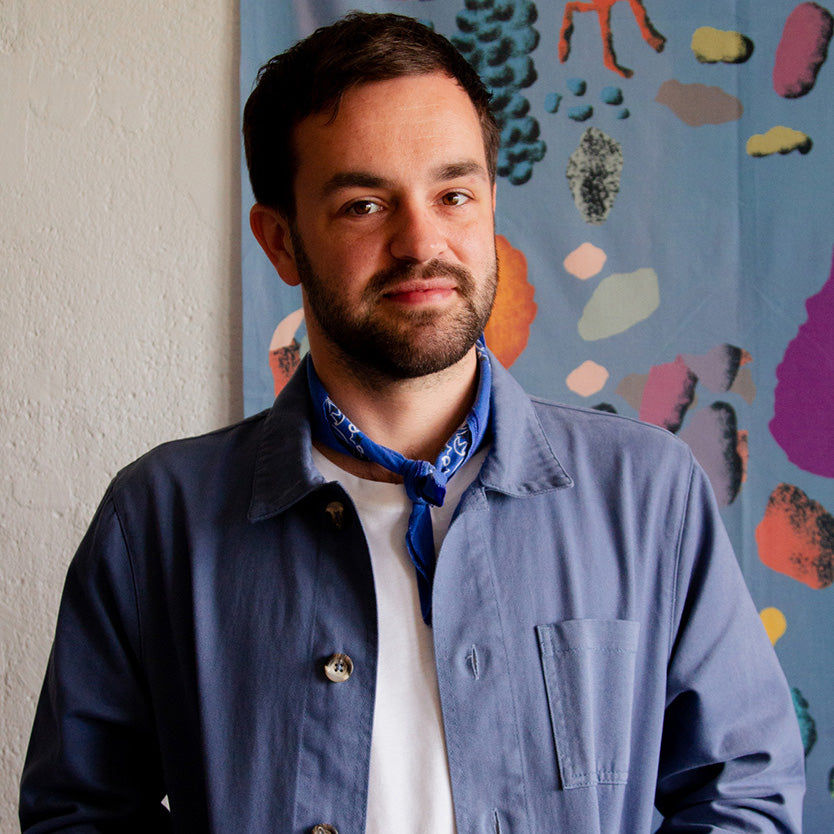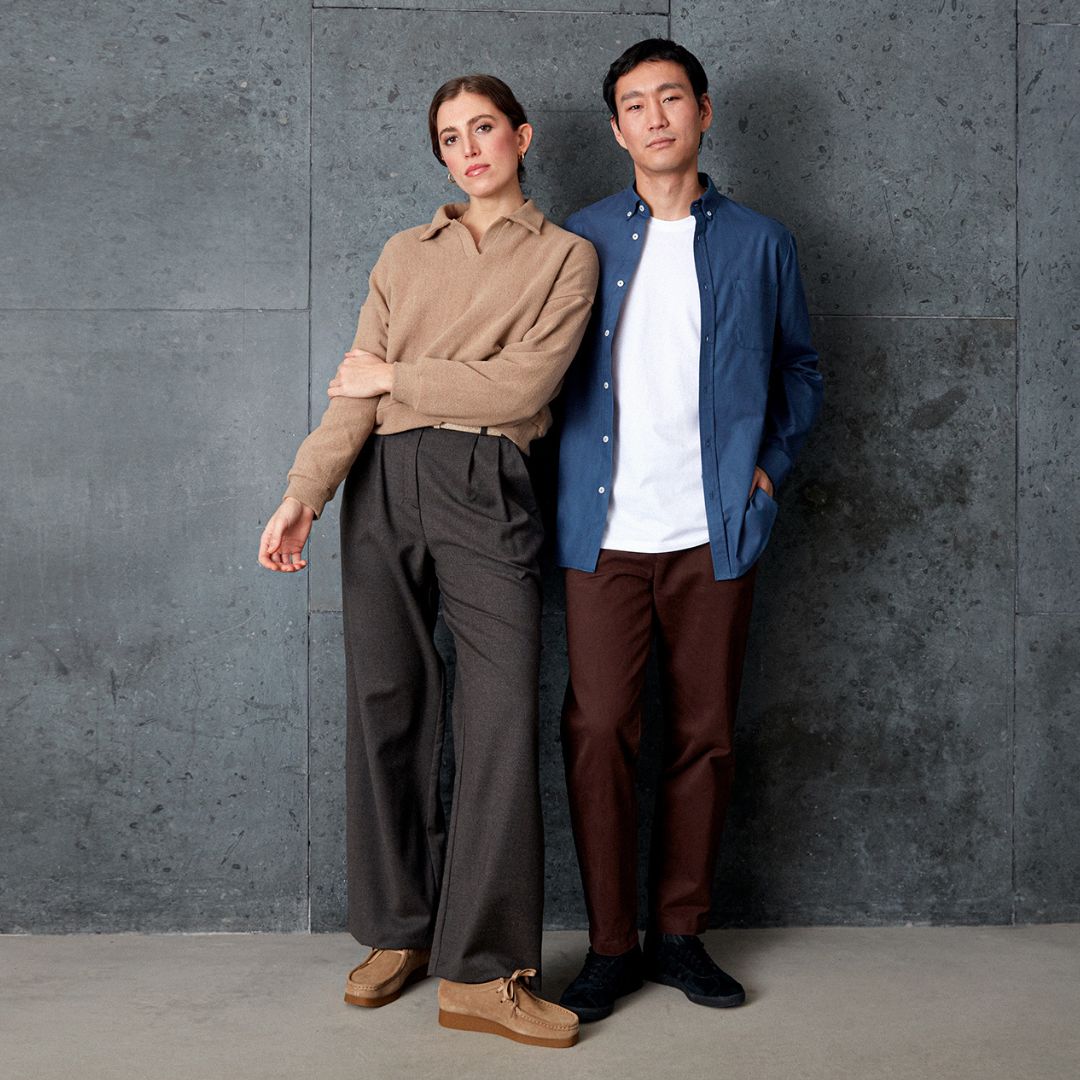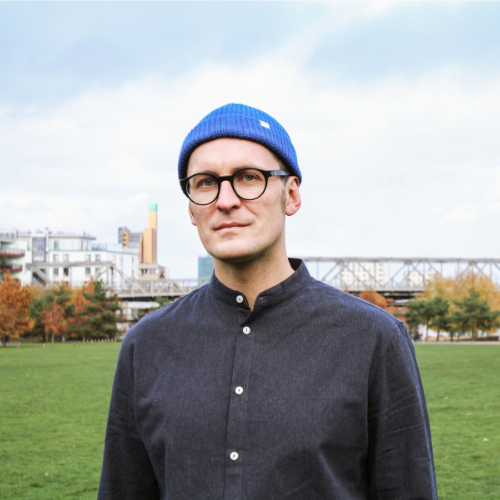Repair as resilience with Tim van der Loo
a chat with Tim van der Loo
One of the secret perks of living in Berlin is the availability of discarded clothes on the streets. Piled inside designated cardboards in front of private buildings or arranged on fences in public squares, abandoned garments are a common fixture of the cityscape, where inhabitants share an interest in re-circulating what is no longer worn but taken to be in good enough conditions for people in need and resourceful passersby to treasure and make use of.
With a focus on denim recycling and upcycling, Dutch Designer Tim van der Loo, embodies this ethos with remarkable passion. As a post consumer waste expert, he also understands that cities like Berlin need better infrastructure to effectively circulate the available clothing and promote repair and reuse as valuable practices and skill sets.
Informed by a prestigious B.A. from the Design Academy in Eindhoven, and an M.A. in Textile and Surface Design from Kunsthochschule Berlin-Weißensee, Tim’s research project “New Blue” and design studio “A New Kind of Blue” were inspired by people’s evolving relationship with materials. Our conversation delved into the challenges of working with waste, his exploratory affair with denim, and the need for reclaiming reuse and upcycling as creative acts and forms of resilience.

"The streets of Berlin are full of stuff, abandoned, discarded. Seeing this really motivated me to work with what’s lying around."
Givn Berlin: Was hat Dein Interesse an Materialien geweckt?
Tim: Ich glaube, das hat mit der Großstadt begonnen, also als ich nach Berlin gezogen bin. Die Straßen Berlins sind voller Zeug, verlassen, weggeworfen. Das zu sehen, hat mich wirklich motiviert, mit dem zu arbeiten, was herumliegt. Schon früh arbeitete ich an einem Projekt, bei dem es um die Wiederverwendung alter Plakate ging. Sie lassen sich wirklich gut schichten, also habe ich angefangen, sie zu sammeln und zu experimentieren. Ich habe einen Stuhl und eine Lampe gemacht. Aufgrund dieser Interessen engagierte ich mich auch intensiv in Projekten, die darauf abzielen, Gemeinschaften und Infrastrukturen aufzubauen, um den Abfall aufzunehmen und ihn in größerem Maßstab neu zu verwerten.
Die Organisation Textilhafen hatte einen großen Einfluss auf meine Praxis. Die Aufgabe der Organisation besteht darin, gebrauchte Kleidung zu sammeln und sie an bedürftige Menschen zu übergeben – Flüchtlinge, Personen mit geringerem Einkommen oder Obdachlose. Es handelt sich um einen Teil der Berliner Stadtmission, der seit langem aktiv ist und Menschen in Not auf vielfältige Weise hilft. Als Reaktion auf die Veränderungen nach dem Fall der Mauer wurde 1994 eine neue Unterabteilung der Berliner Stadtmission, Komm und Sieh, gegründet. Aus Solidarität begannen die Berliner Bürger, Lebensmittel, Werkzeuge, aber auch Kleidung an die verschiedenen Unterabteilungen der Berliner Stadtmission zu spenden. 2019 kontaktierte mich Komm und Sieh und erzählte von einem neuen Projekt: ein Materialpool und eine Sortieranlage namens Textilhafen. Mir wurde angeboten, dem Team als Werkstattleiter beizutreten. Wir haben Workshops mit Kindern durchgeführt, um über das aktuelle Abfallsystem in der Mode- und Textilbranche zu diskutieren – warum der Wert und die Qualität von Kleidung so gering ist, wie es früher war und warum es wenig Infrastruktur gibt. Bei meiner Arbeit dort habe ich die Sortierabteilung ganz genau unter die Lupe genommen.
“Can fashion be a community?” or “can fashion be an art project or a project space?”
Givn Berlin: Hat die Arbeit im Textilhafen auch Dein aktuelles Projekt "A New Kind of Blue” inspiriert?
Tim: Ja, in einem gewissen Maß. Zu dem Zeitpunkt wurde Denim sehr interessant für mich, also sammelte ich jede Menge zerrissene und gebrauchte Jeans und beschloss, mit ihnen zu experimentieren. Ich habe sie auseinander genommen und das Material wirklich im Detail analysiert. Ich hatte die Idee, ein Material und einen Prozess zu schaffen, der es dem Endprodukt ermöglicht, sich weiterzuentwickeln und im Laufe der Zeit relevant zu bleiben. Schließlich gelangte ich zu einem Verfahren, mit dem man Denim mit sehr wenig Ressourcen – Chemikalien, Wasser usw. – zersetzen und wieder zusammensetzen kann. Anstatt den Abfall zu verwenden, um ein neues Endprodukt herzustellen, wie ich es bei den Postern getan habe, habe ich mir eine Möglichkeit ausgedacht, die Fasern in einen Vliesstoff umzuwandeln, der für die Herstellung neuer Jeansverwendet werden kann.
Givn Berlin: Auf welche Herausforderungen bist Du in diesem Prozess gestoßen?
Tim: „A New Kind of Blue“ zu schaffen bedeutete, sich um Fördermittel zu bewerben und an all diesen Programmen teilzunehmen. Das vergangene Jahre waren eine Bewerbungs-Achterbahnfahrt. Ich habe den Bundespreis Ecodesign gewonnen, was eine wirklich schöne Anerkennung für dieses Projekt war, aber ich habe auch sehr viel Zeit damit verbracht, Businesspläne zu schreiben und über Marketing nachzudenken, was mir wirklich keinen Spaß gemacht hat. Ich habe gerade meine letzte Finanzierungsrunde abgeschlossen. Jetzt möchte ich das Projekt überdenken und mich vom kommerziellen Aspekt lösen, um anderen Fragen nachzugehen – „Kann Mode eine Gemeinschaft sein?“ oder „Kann Mode ein Kunstprojekt oder ein Projektraum sein?“ Ich versuche also, weniger in kapitalistischen Systemen zu denken und mehr in Systemen des Austauschs oder der Gemeinschaft.
"Making or repairing something yourself is such a magical thing, it just nourishes your soul, your emotion."
Givn Berlin: Wenn es um Nachhaltigkeit und ein Systemwandel geht, ist Technologie zu einem wichtigen Diskussionsthema geworden. Welche Beziehung hast Du als Materialliebhaber zu Technologie und künstlicher Intelligenz und wie kann Technologie zur Abfallminimierung eingesetzt werden?
Tim: Ich habe eine gewisse Hassliebe zur Technologie, aber ich glaube, dass sie viele Probleme lösen kann. Mode ist zum Beispiel sehr standardisiert und nicht jeder hat sozusagen einen Standardkörper. Durch das Sammeln von Daten stehen uns viele Informationen über Körpertypen zur Verfügung. Es kann dazu beitragen, eine integrativere und vielfältigere Landschaft zu schaffen, in der die Menschen Zugang zu unterschiedlichen Größen haben, oder es einfacher ist, Dinge zu personalisieren. Durch die Technologie entfallen auch viele Schritte in der Lieferkette, beispielsweise die Mustererstellung, die digital durchgeführt werden kann. Dies macht die Arbeit sehr effizient und minimiert Fehler und Verschwendung. Aber ein Teil von mir sagt: Ich liebe das Handwerk. Ich möchte die Materialien berühren, experimentieren, darin Unfälle und Überraschungen erleben.
Givn Berlin: Ja, da ist doch etwas Paradoxes, nicht wahr? Technologie kann uns dabei helfen, Verschwendung auf der Ebene der Lieferkette zu minimieren. Zugleich macht sie gewisse handwerkliche Fähigkeiten redundant und bewirkt dadurch einen gewissen Verlust an Skills und Materialkenntnissen.
Tim: Ja, die Leute vergessen, wie man Dinge repariert. Ich denke, es ist so wichtig, diese Fähigkeiten beizubehalten und weiterhin zu erlernen. Manchmal bekomme ich Fragen wie: „Oh, Tim, kannst du bitte diesen Knopf für mich annähen?“ Und ich sage: „Nein, mach es selbst.“ Schau dir einfach ein YouTube-Tutorial an.“ Es ist nicht so schwierig.
Working with kids has been really eye opening in terms of material literacy and how it works. Kids are amazing because they are very honest and emotional. First, they’re like, No, I don't want to do it. But then two seconds later, they're completely into it. They absorb so much, which is really beautiful. But for grownups, it's really tricky to learn these techniques because we have this boundary of “Oh, I've never done this, so I can't do it.” And it's really, really difficult to get through this barrier.
"It takes a community. You can't do it alone. You have to work together with your friends and with your network and go around in the city."
Givn Berlin: Warum ist es so wichtig, sich trotzdem diesen Grenzen zu stellen und sich die Tutorials anzusehen, wenn man weiß, dass ein Infrastruktur- und systemischer Wandel erforderlich sind, um Verschwendung wirksam zu bekämpfen?
Tim: Etwas selbst herzustellen oder zu reparieren ist so etwas Magisches, es nährt einfach deine Seele. Und es ist so großartig, weil du denkst: „Wow, das habe ich gemacht.“ Ich kann das! Es gehört mir. Das ist Resilienz. Und Resilienz ist für mich eine Form des Aktivismus. [Etwas zu reparieren] hinterlässt dieses Gefühl: „Nein, ich muss es nicht kaufen.“ Ich kann das selbst machen. Und ich kann es so machen, wie ich es möchte, das ist eine große Freiheit und ich persönlich finde das wirklich spannend!
Givn Berlin: Hast du im Rückblick auf diese Erfahrungen einen Rat für junge Designer, die in Berlin etwas ins Rollen bringen wollen?
Tim: Es braucht eine Gemeinschaft. Du schaffst es nicht alleine. Du musst mit deinen Freunden und deinem Netzwerk zusammenarbeiten und in der Stadt unterwegs sein. Es gibt so viele Leute, die bereits Dinge tun. Ich denke, es ist sehr wichtig, seine Freunde zu unterstützen, seinen Freunden zu helfen und gemeinsam Projekte durchzuführen. Als Gruppe, als Gemeinschaft ist man stärker. Fähigkeiten und Wissen teilen: Ich denke, das ist das Wichtigste. Die Modeausbildung konzentriert sich sehr auf den Ruhm, wissen Sie, den einzelnen Stardesigner, und so funktioniert das einfach nicht mehr.
Next Story
"At Work"
In Conversation with Mickey Mouse
To make your blog an effective sales machine, integrate your product into your content in a way that doesn’t scream BUY, BUY, BUY. Here are five steps to provide relevant information and eye-candy to lure readers in and help convert blog posts to sales receipts.
Images: Mick Rock
Words: Theo Adorno

Many companies spend lots of resources and effort to create a blog that supports their business, particularly the sales process. Yet many corporate bloggers complain that while blogs contain relevant information and attract visitors, they can’t track how their blog has influenced sales. Social media has raised customers’ expectations about the information they need before they purchase. If your blog content is relevant to prospects’ and customers’ needs before and after purchase and your products deliver on their promise, you can convert your blog into a sales machine.
3 cs of using your blog to sell
Content. Provide useful, educational and entertaining content. Present information based on your product offering and customers’ problems or needs.
Context. While your end goal is to sell, consider the context of your blog posts. Here, you’re a tour guide through your firm’s extended offering – not an auctioneer. Your job is to show readers how to use your firm’s products.
Commerce. Once you’ve given your readers useful information in a meaningful setting, they may be interested in actually plunking down their credit card. Unfortunately, here’s where many business blogs stop. Blog editors, familiar with their company’s e-commerce site and how to find specific products, can assume readers innately know how to find the product or have the motivation to track it down. Don’t get me wrong. Some very small percentage of prospects will to go extreme efforts to find the product. Unfortunately, the rest will just leave or worse go to your competitor.
Ways to convert your traffic to sales
To make your blog an effective sales machine, integrate your product into your content in a way that doesn’t scream BUY, BUY, BUY. Here are five steps to provide relevant information and eye-candy to lure readers in and help convert blog posts to sales receipts.
Provide useful, relevant information. Show prospects how to use your product, give them instructions or how-tos, and/or entertain them.

Showing making procedure is a good way to guarantee product quality
Include a variety of different forms of content. Photographs and videos are particularly important because readers tend to be visual and want to see your product in action.


Get customer attention by clean visual and video
Make it easy to buy by eliminating stumbling blocks to purchase. Don’t assume customers know which item you’re talking about in your post. Provide a link directly to the product page or just link the product to your blog so they can buy if they want. If it relevant give readers more than one way to get to the product.









